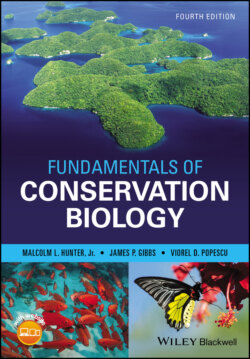Читать книгу Fundamentals of Conservation Biology - Malcolm L. Hunter Jr. - Страница 99
Quantitative Variation
ОглавлениеSo‐called “qualitative variation,” such as allele frequencies in populations, tells us much about how species are organized and their history, but the key traits that most determine fitness are in fact “quantitative” characters, such as height, weight, litter size, seed set, survival rate, etc. (Frankham et al. 2009). Such traits vary continuously because they are polygenic (controlled by many genes) and affected by the environment as well. Adaptive evolution results from changes in quantitative traits, so scientists study quantitative traits because they tell us much about the capacity of a population to evolve in response to environmental change (Storfer 1996). As an example, consider coral reefs, which are threatened by increasing ocean temperatures. Acute temperature increases are stressful for corals, but gradual temperature changes can result in adaptation depending on how heat tolerant a coral is. Heat tolerance is a “quantitative” trait because it varies gradually, relatively higher or lower from individual to individual (versus if it were “qualitative” = heat tolerant or heat intolerant) and is an inherited trait. This natural and quantitative variation in temperature tolerance may facilitate rapid adaptation among corals as our oceans warm (Dixon et al. 2015) with some researchers even suggesting transplanting more heat tolerant coral individuals to reefs that are warming rapidly. As another example, the endangered, annual plant known as the spinster’s blue‐eyed Mary, grows on and off serpentine soils, which have high concentrations of some toxic minerals and low concentrations of some essential nutrients. Plants from serpentine habitats grow best in serpentine habitats, and plants from nonserpentine habitats do best in nonserpentine habitats (Fig. 5.5) even though they are from populations as little as 100 m apart. Restoration efforts need to focus on collecting locally adapted seeds, as using nonserpentine seed sources in serpentine areas may lead to failure (Wright et al. 2006).
Figure 5.5 The native annual plant, Collinsia sparsiflora, grows on [“S”] and off [“NS”] serpentine soils with plants from serpentine habitats growing best in serpentine habitats, and plants from nonserpentine habitats doing best in nonserpentine habitats.
(Adapted from Wright et al. 2006 [left]; Don Loarie [right])
